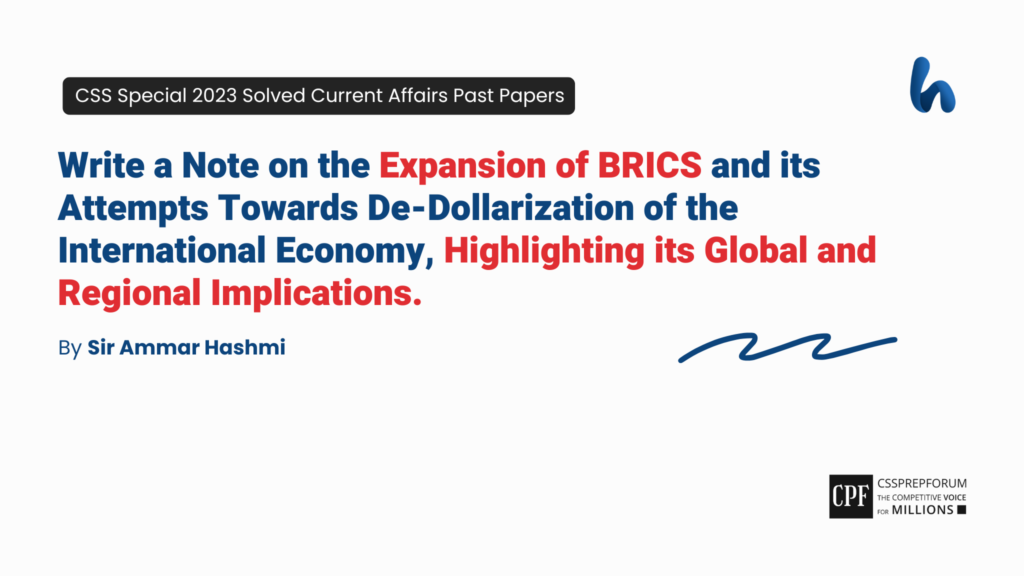CSS Special 2023 Solved Current Affairs Past Papers | BRICS and its Global and Regional Implications
The following question of CSS Current Affairs 2023 Special is solved by Sir Ammar Hashmi, the best Current Affairs Coach, on the guided pattern of Sir Syed Kazim Ali, which he taught to his students, scoring the highest marks in compulsory subjects for years. This solved past paper question is uploaded to help aspirants understand how to crack a topic or question, how to write relevantly, what coherence is, and how to include and connect ideas, opinions, and suggestions to score the maximum.

Question Breakdown
This question has two parts. The first part requires a discussion on the expansion of BRICS, and the second part requires an elaboration of its attempts towards de-dollarization of the international economy by highlighting the global and regional implications.
Outline
1-Introduction
2-BRICS in a Glance
3-The Expansion of BRICS
4-BRICS and Its Attempts towards De-Dollarization
- ✓China-Russia Currency Swap Agreement
- The use of the Yuan in Russia’s foreign exchange reserves has increased from one percent in 2014 to ten percent in 2019.
- ✓India-Iran Rupee-Rial Trade
- India’s foreign exchange reserves of rupees increased from two percent to five percent in 2020.
- ✓BRICS’ New Development Bank
- The New Development Bank’s lending has reached ten billion dollars, of which fifty percent is in local currencies.
- ✓CPEC, The Flagship Project of BRI
- Trade between Pakistan and China has reached twenty billion dollars, with the Yuan accounting for ten percent of Pakistan’s foreign exchange reserves, which is much more than it used to be before CPEC.
- ✓BRICS’ New Currency
- The BRICS nations have been planning to establish their new currency, allowing them economic independence, cross-border free transactions, and a decrease in the U.S.A.’s hegemony.
5-Implications of De-dollarization
✓Global Implications
- Increased Economic Independence
- Russia’s dependence on the U.S.A. has decreased, while its trade with China increased by 25 percent, promoting self-sufficiency.
- Increased Energy Security
- India’s efforts towards de-dollarization have led to more oil imports from Russia, reaching twenty percent in 2020.
- Rise of Emerging Economies
- Having diverted much of its trade from the U.S.A., China has made Taiwan Prosper by increasing its tech exports.
✓Regional Implications
- Enhanced Food Security in the Region
- South Africa’s de-dollarization efforts have led to increased agricultural trade with Russia, resulting in a twenty-five per cent increase in wheat imports, enhancing food security for the region.
- Exchange Rate Volatility
- Replacing the U.S. dollar with another currency would create economic uncertainty, as no other standard currency exists.
- Enhanced Regional Co-operation
- The BRICS Nations’ share in global trade has increased from ten per cent to twenty per cent in 2020 by making trade among these countries easy and friendly, which promotes regional peace and prosperity
6-Critical Analysis
7-Conclusion

Answer to the Question
Introduction
Since the inception of the world, the world has seen many rulers. Previously, the rule was based on military power and strength. Whichever nation or nations had a workforce and a strong military would become the ruler or rulers of the world. However, recently, in the twenty-first century, the course of rulers has changed drastically. The economic hegemony, not military strength, now makes a country lead and rule the world. The same is the case with the U.S.A., which first ruled as a military power in the nineteenth century and now ruled as an economic hegemon. But, with the evolution and change in the course of the rulers, the being ruled countries have also been developing, and they, as of now, have been trying to achieve independence from the U.S.A., the hegemon, giving rise to BRICS and the doctrine of de-dollarization. BRICS nations have been formed to allow inter-countries free and fair transactions without involving the U.S. dollar; hence, they would decrease dependence on the U.S.A. and its currency, leading to dollarization. However, these steps have some implications, good and bad. For instance, it would lead to the economic independence of these countries and many others, enhanced energy security, food security, and the promotion of regional cooperation.
BRICS in a Glance
To begin with, it is imperative to shed some light on the organization BRICS. Established in 2009, it only had four members, which increased to five when South Africa joined it in 2010. It is one of the largest inter-governmental organizations, replacing G7 in its global GDP share. BRICS comprises thirty-five per cent % of the world’s GDP, making it one of the leading economic powers. Its headquarters is in Shanghai, where the New Development Bank is. Moreover, BRICS holds annual summits in which its members and invited countries participate. This alliance aims to work on peace, cooperation, and economic development of the region and globally.
The Expansion of BRICS
Having explained what BRICS is, a glance at the expansion of BRICS holds much value. In 2009, BRICS was only an alliance of four members: Brazil, China, Russia, and India. Then, in 2010, it was joined by South Africa, making it a five-member alliance. Since then, the idea of BRICS expansion has been in vogue, and many countries, including Pakistan and other Asian countries, have applied for membership. However, membership in BRICS is solely given to those who fulfil the criteria. For instance, a country should undergo three stages: Contingent Reserve Arrangement, BRICS Business Council, and New Development Bank. After these three stages, a country is eligible to join the BRICS. Recently, in 2024, the U.A.E., Egypt, Ethiopia, and Iran joined BRICS, as they fulfilled the criteria to join BRICS.
BRICS and Its Attempts Towards De-Dollarization
Furthermore, BRICS has also long been known for its efforts towards de-dollarization to minimize the U.S.A.’s hegemony in the world.
- China-Russia Currency Swap Agreement:
BRICS has taken many scrupulous steps towards de-dollarization. For instance, Russia and China 2014 signed a currency swap agreement to avoid using the U.S. dollar and use the yuan and Rubel for trade. As per the Russian Central Bank report, the use of yuan in Russia’s foreign exchange has increased from one per cent in 2014 to ten per cent in 2019. Moreover, the Chinese Customs reported a twenty-five per cent increase in 2015 trade between China and Russia, decreasing the dependence on the U.S.A.
- India-Iran Rupee-Rial Trade:
Second, in 2018, Iran and India signed an agreement to use Rials and rupees for oil trade between the two countries despite the U.S.A.’s sanctions on Iran. The aim is to bypass the U.S. dollar and increase trade in local currencies. The Indian Ministry of Commerce reports that India’s oil import from Iran increased by thirty per cent, 300,000 barrels per day in 2019. Also, the use of rupees in India’s foreign exchange reserves reached five per cent in 2020 from two per cent in 2018, as stated by the Reserve Bank of India. These efforts indicate how India and Iran have been gradually moving towards de-dollarization.
- BRICS’ New Development Bank:
Third, the development of the New Development Bank by BRICS to challenge international financial institutions, such as IMF and WB, poses a severe threat to the hegemony of the U.S.A.’s dollar globally. The bank works so that it lends money to the recipient countries in local currency, bypassing the U.S. dollar. The New Development Bank stated that the bank’s lending reached ten billion dollars in 2020, with about half of the loans disbursed in local currencies. Moreover, a report by SWIFT also highlights that the share of BRICS’ global trade finance has increased from 15 per cent in 2015 to 20 per cent in 2020, making it hard for the U.S.A.’s dollar to maintain its hegemony over the world’s trade.
- CPEC, The Flagship Project of BRI:
Fourth, BRI, Belt and Road Initiative, one of the leading initiatives known for infrastructure development, is also a step towards de-dollarization indirectly. Its flagship project, CPEC, has promoted trade between Pakistan and China by up to twenty-five per cent, reaching twenty billion dollars in 2019, and it’s still going up, as Pakistan’s Ministry of Commerce reported. Further, the State Bank of Pakistan acknowledged that the use of yuan in Pakistan’s foreign exchange reserves increased from one per cent in 2018 to ten per cent in 2020. Many other projects under BRI are being done in the same pattern to counter the U.S.A.’s hegemony and lessen the dependence on the U.S. dollar.
- BRICS’ New Currency:
Finally, the BRICS alliance has been working to introduce a new currency that can challenge the U.S. dollar, another critical move towards de-dollarization. The BRICS currency has not been established yet; however, the BRICS blockchain payment system, known as the BRICS bridge multisided payment system, is discussed a lot. With this, not only would the BRICS nations strengthen their economic cooperation, but they would also give a tough time to the U.S. dollar. Although it seems complicated for the new currency to cancel out the hegemony of the U.S. dollar altogether, it would still be an abyss for the U.S. dollar and its hegemony in the world’s trade.
Implications of De-dollarization
Seemingly, de-dollarization brings with it a great many implications, good and bad, globally and regionally.
A- Global Implications
- Increased Economic Independence
The world has decreased economic dependence on the U.S.A.; conversely, it has increased trade between economies. For example, Russia’s dependence on the U.S.A. has much reduced, but the latter’s trade with China, on the other hand, has reached up to twenty-five per cent in 2020, as highlighted by the Russian Customs’ reports. Moreover, Iran, India, and South Africa follow the same pattern, strengthening trade among the states while bypassing the U.S.A. This shows the independence of these nations and many more on the U.S.A. for trade and economic development.
- Increased Energy Security
Second, the de-dollarization also has another positive global impact: alleviating global energy security problems. For example, India and Russia have signed a deal to import and export oil in their local currencies, making the oil trade easy and fulfilling India’s oil requirement. The Indian Ministry Of Petroleum states that the oil imports from Russia have increased by up to twenty per cent in 2020. Moreover, India has also signed oil agreements with Iran, despite the sanctions by the U.S.A., making India minimize its oil deficit and simultaneously decrease the hegemony of the U.S.A.
- Rise of Emerging Economies
Third, the de-dollarization efforts have made the emergence and development of developing economies possible. Since the start of the China-U.S. trade war and de-dollarization efforts by BRICS, the tech exports of Taiwan have increased significantly, as China and other nations have started importing tech from Taiwan instead of the U.S.A. On the other hand, Brazil’s exports have also increased by leaps and bounds, owing to de-dollarization efforts and BRICS. As the Brazilian Ministry of Commerce states, the trade between Brazil and China has reached eighty billion dollars. Moreover, Brazil’s foreign exchange reserves now comprise five per cent yuan.
B- Regional Implications
De-dollarization also has some regional implications. The most significant among them are as follows.
- Enhanced Food Security in the Region
First, de-dollarization efforts have also been aimed at decreasing agricultural dependence on the U.S.A. For example, South Africa has been strengthening its agriculture trade with Russia in their local currencies, which has resulted in a twenty-five percent increase in wheat imports, as acknowledged by the South African Revenue Service in one of its reports. These efforts aim to bypass the U.S.A. and its currency in doing trade among the other nations, especially the BRICS nations.
- Exchange Rate Volatility
Second, not all the implications are good; some are also bad. For example, establishing a new currency is problematic, as there is no standard for which country’s currency will rule. The BRICS nations might themselves start conflicting with each other over the issue. Developing nations like Pakistan might find it difficult and troublesome for their economies. These developing nations would then face problems in trade, loan repayment, interest repayments, foreign aid disbursement, and many more. In a nutshell, new currency and de-dollarization, on the one hand, help developed nations develop economically. Still, on the other hand, they have become an acapus issue for underdeveloped countries.
- Enhanced Regional Co-operation
Third, de-dollarization efforts have also contributed to regional cooperation and regionalization while decreasing dependence on the U.S.A. As a report by the IMF explains, the BRICS nations’ share in global trade has increased from 10 per cent in 2010 to 20 per cent in 2020.
These nations and many other developing and developed nations have indulged in trade with each other in their local currencies, which not only overcomes their dependence on the U.S. dollar but also strengthens their regional bonds, making them grow and develop altogether.
Critical Analysis
Critically, de-dollarization is, as said by the twenty-first century’s scholars, inevitable, for the U.S.A. had put the trade market under its control. Whenever the U.S.A. wanted to fluctuate the dollar rate, it would increase the U.S.A.’s banks’ interest rates, leading to an accumulation of dollars in the banks. At the same time, the dependent nations would then face an increase in inflation. All these steps of the U.S.A. have forced these nations to take some sensible steps to overcome their dependence on the U.S. dollar and make their economic system where they can have their say and use their local currencies. Their efforts led to the establishment of BRICS, which has set the notion of de-dollarization afire. However, it is still far away from being entirely workable. The U.S. dollar still leads the race. The BRICS nations and others still have much homework to nip in the bud the hegemony of the U.S. dollar.
Conclusion
To conclude, BRICS, established in 2009, aims to strengthen global and regional economic cooperation. Still, on the other side, its main aim is to burn the hegemony of the U.S. dollar to ashes. For this, the BRICS nations have taken multiple steps, such as the China-Russia currency swap agreement, the India-Iran Rupee-Rial agreement, and the establishment of the New Development Bank. These de-dollarization steps have brought some pros and cons as well. For example, it has promoted global trade, economic independence, and energy security and helped emerging economies rise. On a regional level, it has facilitated the regional food security issue, and regional trade and cooperation have strengthened; unfortunately, it also poses a severe threat to developing nations due to the new currency volatility issue. Though seemingly an exciting issue, de-dollarization feels like a dream for many.

CSS 2023 Special Solved Current Affairs
CSS Solved Past Papers’ Essays
Looking for the last ten years of CSS and PMS Solved Essays and want to know how Sir Kazim’s students write and score the highest marks in the essays’ papers? Then, click on the CSS Solved Essays to start reading them.
CSS Solved Essays
CSS Solved General Science & Ability Past Papers
Want to read the last ten years’ General Science & Ability Solved Past Papers to learn how to attempt them and to score high? Let’s click on the link below to read them all freely. All past papers have been solved by Pakistan’s top CSS GSA coach having the highest score of their students.
General Science & Ability Solved Past Papers












